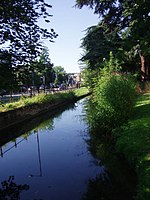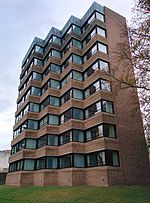Memorial Chapel, The Leys School

The Memorial Chapel of The Leys is situated on the grounds of The Leys School, Cambridge, England. It was built as a memorial to the first headmaster of The Leys, William Fiddian Moulton. Plans for the chapel, designed by architect Robert Curwen, were first presented to the school's second headmaster, W. T. A. Barber; he deemed the project an unnecessary luxury. School services continued to be held instead in the school hall, until 1904 when the school governors approved the chapel's construction. The cost, including all furnishings, was estimated in 1925 to have been £39,000. The foundation stone was laid at the marble West Door by Princess Helena of Waldeck and Pyrmont on 8 June 1905 and the chapel was consecrated on 27 October 1906. The building's design is Gothic Revival, to complement the surrounding buildings. All visible woodwork is in oak. The roof comprises elaborately worked trestles and tracery, somewhat after the lines of the famous roof of Westminster Hall. The floor is of alternating black and white marble. The chapel was designed to seat 350 boys, with the west balcony reserved for household staff.
Excerpt from the Wikipedia article Memorial Chapel, The Leys School (License: CC BY-SA 3.0, Authors, Images).Memorial Chapel, The Leys School
The Fen Causeway, Cambridge Newnham
Geographical coordinates (GPS) Address Website Nearby Places Show on map
Geographical coordinates (GPS)
| Latitude | Longitude |
|---|---|
| N 52.1968 ° | E 0.1214 ° |
Address
The Leys School
The Fen Causeway
CB2 7AD Cambridge, Newnham
England, United Kingdom
Open on Google Maps







